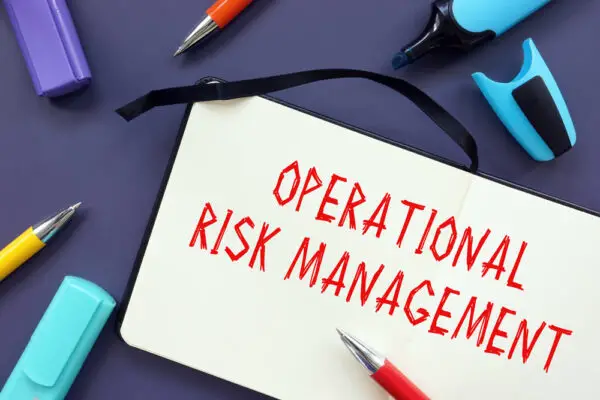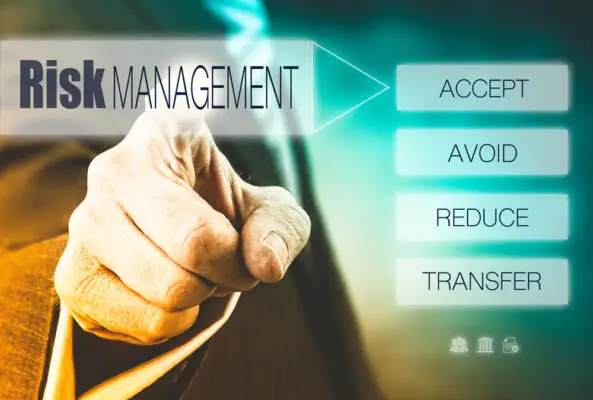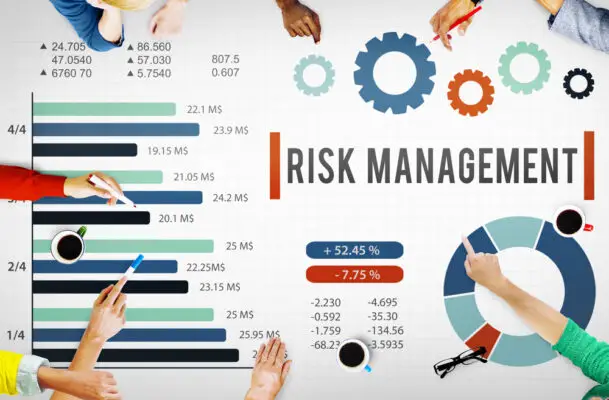Operational risks are risks that can arise from the day-to-day operations of an organization. They can include everything from natural disasters to data breaches. Here are some common examples of operational risks.
Natural disasters. Floods, fires, and earthquakes are natural disasters that can disrupt business operations. In some cases, such as with floods and earthquakes, organizations may be unable to resume operations for weeks or even months.
Data breaches. A data breach occurs when sensitive, confidential, or proprietary information is released without authorization.
Data breaches can be extremely costly regarding financial losses and damage to an organization’s reputation.
IT outages. An interruption in an organization’s IT systems can ripple throughout the business, impacting everything from employee productivity to customer satisfaction.
Supply chain disruptions. Disrupting an organization’s supply chain can lead to shortages of raw materials, finished goods, or both. This, in turn, can result in lost revenues and damaged relationships with customers and suppliers.
Regulatory changes. Changes in laws and regulations can impact an organization’s ability to do business in a particular jurisdiction. For example, changing environmental regulations might require an organization to change its manufacturing process significantly.
Economic downturns. A recession or other economic downturn can decrease demand for an organization’s products or services, leading to layoffs, plant closures, and other cost-cutting measures.
Reputational damage. An incident that damages an organization’s reputation can have far-reaching consequences, including loss of market share, decreased sales, and damage to relationships with employees, customers, and other stakeholders.
Terrorist attacks. Unfortunately, terrorist attacks are becoming more common worldwide. If an organization is targeted, it could suffer devastating consequences regarding physical and reputational harm.
Pandemics . A pandemic is a global outbreak of disease. The most recent example is the COVID-19 pandemic, which has led to widespread shutdowns of businesses, schools, and other institutions.
Cyberattacks . Cyberattacks are becoming more common and more sophisticated. They can have a devastating impact on an organization, leading to loss of data, financial losses, and reputational damage.
Cyberattacks can also cripple critical infrastructures like power grids and hospital networks.
Senior Management sees risks from the other perspective, while traditional Risk Management approaches aim to achieve an optimal balance between risks and rewards.
Sometimes organizations will risk accepting more risk to gain the ability to improve their business faster, and sometimes the focus shifts to controlling risk while slowing down the development rate.
Operational risk management is risk-averse and focuses on defending a business by monitoring key indicators.
Operational risk management (ORM) is an ongoing and recurring process involving risk assessment, decision-making, and implementation of risk controls enabling risk mitigation.
Each organization faces varying risks that can be presented to them, from small inconveniences to situations where the whole company is at risk. Organizations follow an operational risk management process for the management of risk.
Since then, methodologies for evaluating internal controls and risk have become standard. The government initiated standardization as a reassurance of risks and effective measures to reduce them.
There are other categories of risks, from strategic risks to compliance and financial.
The release of the COSOs internal controls integrated framework and the Sarbanes-Oxley Compliance Act in 2002 have pressured organizations to have effective operational risk management discipline.
Many organizations have created an operational risk management function.
If you’re in business, you know risks are associated with every decision. Sometimes those risks are worth taking, and other times they’re not. But how do you decide which risks are worth taking?.
This post will explore some common operational risks and give examples of when they might be appropriate (or not).
We’ll also talk about ways to mitigate these risks if they are taken. So whether you’re a seasoned pro or just starting out, read on for some helpful insights into operational risk management!

What is Operational Risk Management’s primary objective?
As the name implies, operations risk management primarily aims to manage the risks in everyday operations. Operational Risk Management focuses on operational risk, while other risks include financial and strategic risks.
Operational risk managers’ positions are created to adhere to Basel recommendations.
Operational risk is inevitable in any business, especially in financial institutions like banks. The Bank for International Settlements, Basel Committee, and chief risk officers around the globe have recognized operational risk as a discipline within risk management critical to maintaining financial stability.
As defined under Basel II and Basel III, operational risk pertains to loss resulting from inadequate or failed internal processes, employee errors, systems risk, or external events.
This includes legal and reputational risks, which may result from internal fraud, external fraud, or misconduct by bad actors among employees.
Artificial intelligence and structured communication lines have proven effective in identifying potential risks and maintaining transparency in daily operations, reducing disruptions and unnecessary risks.
Companies like Company A are constantly challenged by non-financial risks such as compliance risks, third-party risks, and environmental risks, which are integral parts of operational risk exposure.
Additionally, financial firms, including American banks and European insurance firms, face unique risks, like credit risk and credit costs, that are specific to their industry and heavily influence their operational risk profile.
Risk identification is a crucial process in managing operational risks. This involves mapping people risks, reviewing business processes, and using tools like the LogicGate Risk Cloud for tracking operational risk events.
Operational processes can often be sources of operational losses due to disruptions, accounting errors, and physical events. Therefore, monitoring of suspense accounts, employee conduct, and access controls are essential.
In light of these risks, the Basel Committee on Banking Supervision has laid down capital requirements under the capital adequacy framework.
Financial institutions must maintain a capital reserve or charge to safeguard against operational risks. Additionally, there are regulatory requirements to adhere to, such as Anti-money laundering (AML) policy Tier, Transparent remuneration policies, and a Risk-tracking policy.
Moreover, maintaining a healthy business environment involves the periodic training of staff and a focus on social performance and corporate performance. Compliance with relevant policies and standards, alongside effective crisis management, can lead to an acceptable level of risk, contributing positively to the company’s overall operational risk framework.
While operational risks can pose significant challenges to a company’s assets and reputation, an effective risk management capability can help mitigate these risks. This involves a robust understanding of the different types of risks, diligent monitoring, and compliance with regulatory requirements. By doing so, companies can ensure the smooth functioning of their operations and contribute to their long-term success.
While other risk disciplines, including ERM, emphasize optimizing risk appetite for balanced risk-take and potential rewards, the ORM processes largely focus on controlling and eliminating risk.
ORM begins by defining risk and selecting mitigation strategies for operations risks starting with failed internal processes and external events. Effective operational risk management will be assured when the primary objective is met.
Technology
Technology risks in the operating sense include hardware security. As mentioned, tech risks are spread across broader organizations and the people category. Hardware limitations may inhibit productivity, particularly when working remotely.
Risk management integration can be adhered to when technology is used in management of risks.
The software also reduces productivity unless application improvements or staff are not trained. It affects customer interaction and interactions with the business itself.
Viruses are commonly used as tools by hackers who seek information, e.g., eavesdropping on computers if they have access. The result might be a leakage of customer information.
Regulations
Risks of noncompliance exist in almost all industries. Some industries have higher regulations, but regulations generally involve operationalizing internal controls.
The length of the regulation has risen, and penalties have recently increased. Examples of operational risk might originate from technology.
Understanding the source of the risks is useful in managing operational risks. Enterprise and Operations risk managers manage risks at the same level and from different perspectives. Several companies are integrating IRM with other disciplines.
People
The person category includes customers, suppliers, or other stakeholders. Employing employees is risking human error and intentional wrongdoing. Risks include breach of policies, lack of instruction, or poor training.
Besides the organization, there can also be operational risks involving people. Social media has a high potential for employees to take risks. Observing and controlling the human aspects of operational risk are among the broadest coverage areas.
Operational Risk vs. Financial Risk: What’s the Difference?
Financial risk refers to the potential loss or reduction of value in assets, income, or the overall financial health of a company. This can include market risk, liquidity risk, and credit risk.
On the other hand, operational risk involves potential losses resulting from inadequate or failed internal processes and systems, human errors, or external events.
This includes data breaches, natural disasters, supply chain disruptions, and legal compliance issues.
While both types of risks can have serious consequences for a business, operational risks tend to receive less attention and often catch companies off guard.
Businesses must have clear strategies for identifying and mitigating financial and operational risks.
Poor management of operating risks can affect the level of financial risk a company faces. Financial risk indicates that companies can pay off their credit card debts by reducing payroll expenses or maintaining an adequate investment in infrastructure and services.

How does Operational Risk Management work?
The organization is responsible for examining the operational aspects of its objectives. As operational risks are ubiquitous, the project aims to limit and manage all risks reasonably.
Operating risk management seeks to reduce risks by identifying and measuring risk assessments, reducing them, and monitoring the operating risk management system.
Monitoring and reporting
Risks will be analyzed in continuous risk analysis and can change whenever a risk change, senior management and board members must report them to facilitate decisions.
Challenge of Operational Risk Management Process
In the business world, operational risk is the potential for loss resulting from inadequate or failed internal processes, people, or systems.
This type of risk can have a significant financial impact on a company, so managing it is crucial.
However, there are several challenges associated with the operational risk management process. One issue is determining what risks need to be prioritized and tackled first.
Another challenge is accurately assessing a risk’s potential impact and probability, which beats the importance of enterprise risk management erm.
Additionally, balancing risk mitigation efforts with implementing those measures’ costs can be difficult.
Despite these challenges, companies must continuously strive to identify and address operational risks to stay successful in today’s competitive market.
In many companies, operational risk management is key to meeting customer requirements.
Although operational risks are a subset of enterprise risk management, the same difficulties, such as conflicting priorities and lack of perception of value, affect the proper development of each program.
How many steps are involved in ORM?
Operational risk management generally operates on a five-step approach. The first two are crucial. These steps follow the risk management process steps of ISO 31000:2018. There are many key risk indicators for operational risks.
Identification of risks
Identifying risks can help control this. Risk assessment starts by understanding the organizational objectives.
Risks mean everything that hinders organizations from achieving their goals. This is the first step of an effective operational risk management program.
Control. Implementation
When risk mitigation is decided, implementation is needed. Control measures are specifically aimed at the risks concerned.
A controller must efficiently document the control objectives, activities, and rationales and provide clear communication and execution. In this way, the control should concentrate preventive control activities on policies.
Risk mitigation
The risk mitigation steps are based on determining the path in control of the risk. Operational risk management has four ways to mitigate risk: transferring, avoiding, accepting, and controlling.
Transfer: Transfer of risks to other companies and institutions. Typically, outsourcing is done by a company outsourcer or an insurer. The mitigations must align with the organization’s ultimate operational risk management framework.
During outsourced work, management cannot assume complete control over risks. Ultimately insurance companies can pay for some of their costs by transferring the risk to insurers. Among the best examples of risk transfer is cloud software.
Monitoring
Because controls could be implemented by people making mistakes or the environments could be changed, it is necessary to monitor them. Control monitoring involves checking if controls have been properly implemented or operated.
The management must decide by the outlined plans whenever any exception is made. Financial institutions and companies often use monitoring systems in the operational risk management phase, particularly to monitor risk indicators (KRIs).

Conclusion
Operational risks are real, and they need to be taken seriously. By understanding the common types of operational risks, organizations can be better prepared to deal with them when they occur.
Preparing for operational risks involves having robust policies and procedures and contingency plans for when things go wrong. Operational risk management is an essential part of running a successful business.

Chris Ekai is a Risk Management expert with over 10 years of experience in the field. He has a Master’s(MSc) degree in Risk Management from University of Portsmouth and is a CPA and Finance professional. He currently works as a Content Manager at Risk Publishing, writing about Enterprise Risk Management, Business Continuity Management and Project Management.

